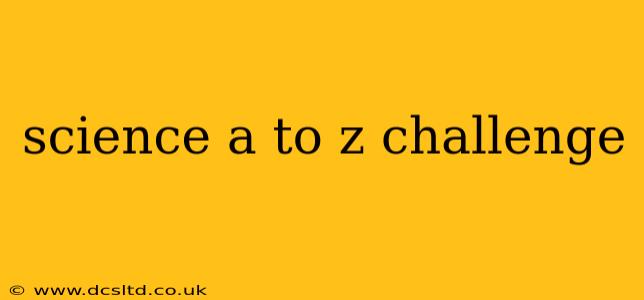The world of science is vast and endlessly fascinating. From the tiniest subatomic particles to the largest galaxies, there's always something new to discover and understand. This "Science A to Z Challenge" aims to explore a range of scientific concepts, one letter at a time, sparking curiosity and deepening your appreciation for the scientific method and its incredible achievements. This isn't a comprehensive encyclopedia, but rather a starting point for your own scientific explorations.
A is for Astronomy: Unveiling the Cosmos
Astronomy, the study of celestial objects and phenomena, has captivated humanity for millennia. From ancient stargazers charting constellations to modern astronomers using powerful telescopes like the Hubble, our understanding of the universe has continuously expanded. We've mapped galaxies, discovered exoplanets, and probed the mysteries of black holes. Astronomy constantly pushes the boundaries of our knowledge, revealing the vastness and complexity of the cosmos.
B is for Biology: The Science of Life
Biology, the study of living organisms, encompasses an incredible array of disciplines. From cellular biology to ecology, biologists investigate the intricate mechanisms that govern life. They study the diversity of species, the processes of evolution, and the intricate interactions within ecosystems. Recent advancements in genetic engineering and biotechnology have revolutionized our understanding of life and its potential.
What are the different branches of biology?
Biology is a vast field with many specialized branches. Some of the most prominent include zoology (the study of animals), botany (the study of plants), microbiology (the study of microorganisms), genetics (the study of heredity), ecology (the study of the relationships between organisms and their environment), and molecular biology (the study of biological molecules). Each branch offers unique insights into the complexities of life.
C is for Chemistry: The Study of Matter
Chemistry explores the composition, structure, properties, and reactions of matter. It's the foundation for understanding the world around us, from the air we breathe to the food we eat. Chemists analyze molecules, develop new materials, and investigate chemical processes crucial to various industries, from pharmaceuticals to manufacturing. The periodic table, a fundamental tool in chemistry, organizes the elements based on their atomic structure and properties.
D is for DNA: The Blueprint of Life
Deoxyribonucleic acid (DNA) is the molecule that carries the genetic instructions for all living organisms. The discovery of its double helix structure revolutionized biology, leading to advancements in genetics, medicine, and biotechnology. Understanding DNA allows us to explore heredity, genetic diseases, and the possibilities of gene editing.
How does DNA work?
DNA works by encoding genetic information in the sequence of its four nucleotide bases: adenine (A), guanine (G), cytosine (C), and thymine (T). These bases pair up (A with T, and G with C) to form the double helix structure. This sequence determines the order of amino acids in proteins, which carry out various functions in the body. DNA replication and transcription are crucial processes that allow for the transmission of genetic information from one generation to the next.
E is for Evolution: The Engine of Change
Evolution, the change in the heritable characteristics of biological populations over successive generations, is a cornerstone of modern biology. Driven by natural selection, evolution explains the incredible diversity of life on Earth. Understanding evolution allows us to trace the ancestry of species, predict future adaptations, and appreciate the interconnectedness of all living things.
F is for Physics: Understanding the Universe’s Fundamental Laws
Physics explores the fundamental constituents of the universe and the laws that govern their behavior. From classical mechanics to quantum mechanics, physics has provided a framework for understanding motion, energy, forces, and the structure of matter. Developments in physics have led to groundbreaking technologies, such as electricity, lasers, and nuclear energy.
G is for Geology: Exploring Earth's History and Structure
Geology is the study of Earth's solid matter, its structure, and its history. Geologists investigate rocks, minerals, and geological processes, such as earthquakes, volcanoes, and plate tectonics. Understanding geological processes is crucial for managing resources, mitigating natural hazards, and comprehending Earth's evolution.
(This is a partial example. The complete "Science A to Z Challenge" would continue in this fashion, covering letters H through Z with similarly detailed explanations and addressing potential "People Also Ask" questions for each letter.)
This "Science A to Z Challenge" provides a foundational understanding of several key scientific disciplines. Further research into each topic will reveal even more intricacies and fascinating discoveries. The world of science is vast and constantly evolving—embracing curiosity and a thirst for knowledge is key to unlocking its endless wonders.
